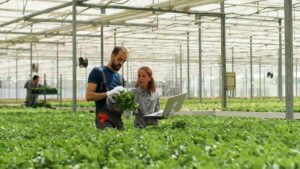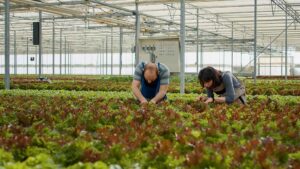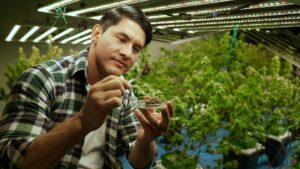Vertical farming is an exceptional agricultural technique that provides effective, long-term answers to some of the most significant problems facing food production today. It is a promising substitute for conventional farming since it grows crops under controlled conditions, using less land, water, and dangerous pesticides.
Despite obstacles like high expenses and energy consumption, technological developments and an emphasis on sustainability can make vertical farming a vital component of food systems in the future.
This is a different way of agriculture where crops are cultivated in stacked layers using contemporary agricultural techniques, normally in controlled indoor spaces.
Contrary to conventional farming, which depends on expansive fields and ambient weather, vertical farming, makes use of technologies such as climate control, hydroponics, and artificial lighting to effectively cultivate plants. It’s a creative method of growing food in cities or locations with little farmland.
Vertical farming is a revolutionary change in agricultural methods; that tackles the twin problems of environmental deterioration and urbanization. This technique maximizes land utilization, significantly lowers water use, and prepares away with the need for chemical pesticides by growing crops in controlled settings in vertically stacked layers. Furthermore, Precision farming techniques are now possible due to technological developments like hydroponics, LED lighting, and artificial intelligence, which guarantee constant yields and resource efficiency.
Notwithstanding its drawbacks, including high energy requirements and upfront setup expenses, vertical farming is a pillar of sustainable food systems through the incorporation of renewable energy sources and scaling advances.
Vertical farming is not just a substitute, but a required development in an era of population increase, climate change, and declining arable land to maintain ecological balance and global food security.
The world needs to shift towards the choice that leaves the least possible prints on environments. However, things should be kept in mind like the after-effects of such practices or what is needed to appropriately execute them.
What Is the Process of Vertical Farming?

Growing crops in vertically stacked layers which can be done in greenhouses, shipping containers, or buildings is the main goal of vertical farming. Hydroponic (water-based) and aeroponic (air-based) systems, which supply nutrients directly to the roots, are frequently used to grow plants in place of soil.
To provide the ideal conditions for plants, artificial lighting such as LEDs simulates sunlight, while sensors keep an eye on temperature, humidity, and nutrient levels.
In comparison to conventional farming, this approach minimizes water use, permits year-round output, and lessens the need for pesticides.
Examples and Current Uses

- Tokyo’s Pasona Urban Farm grew rice, tomatoes, and mushrooms while integrating farming into an office building.
- Despite the high expenses, companies such as Oishii use vertical farming to raise premium commodities like strawberries.
Furthermore, there are advantages of Vertical Farming;
Effective Use of Space: Urban areas with limited land can grow food due to vertical farming. It is possible to turn skyscrapers, warehouses, and even basements into farms.
Water Conservation: Because water is recycled within the system, vertical farming can use up to 90% less water than regular cultivation.
Pesticide-Free: Since plants are cultivated in regulated conditions, dangerous chemicals are not required to safeguard crops.
Year-Round Harvests: Crops can be grown year-round indoors under regulated conditions, irrespective of the weather or seasons.
Reduced Food Miles: By producing food closer to where it is consumed, transportation expenses and emissions can be decreased.
What can be possible Difficulties with Vertical Farming?

Vertical farming has drawbacks despite its many advantages.
High Initial Costs: Installing these farming systems necessitates a large infrastructure and technical investment.
Energy Use: Some of the environmental advantages may be outweighed by the high electricity use of climate control systems and LED lights.
Restricted Crop Variety: Leafy greens, herbs, and tiny fruits are the best crops for vertical farming. These technologies are not yet viable for larger crops like corn or wheat.
Skill Requirements: Technical expertise, such as the ability to monitor sensors and run hydroponic systems, is necessary for managing a vertical farm.
Technology-Powered Vertical Farming

Advanced technologies are essential for the success of vertical farming;
Aeroponics and hydroponics: These techniques give plants nutrition directly without the need for soil.
LED Lighting: These energy-efficient lights can be adjusted to optimize plant development by simulating natural sunshine.
Artificial Intelligence (AI): AI programs keep an eye on and adjust growing conditions, increasing productivity and reducing labor costs.
Integration of Renewable Energy: By lowering dependency on grid electricity, solar or wind turbines can increase the sustainability of vertical farms.
Nonetheless, Vertical farming has the potential to completely transform agriculture as the world’s population increases and arable land becomes more limited. It has the potential to be a significant solution for urban food security by lowering reliance on conventional farms and minimizing environmental effects. Future developments such as increasing crop diversity, incorporating renewable energy, and scaling up production techniques may make vertical farming more viable and accessible.
Because vertical farming depends on steady energy, it could not be practical in areas where subsistence farming is the norm.
It Might support conventional farming by concentrating on high-value crops and easing land strain.
Although it has drawbacks in terms of cost, energy consumption, and crop limits, vertical farming has potential in urban areas and niche markets. Although it isn’t now prepared to take the place of conventional farming, it might develop into a crucial component of sustainable agriculture.













